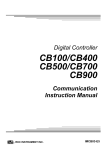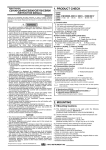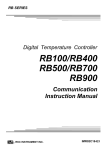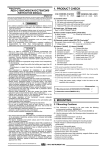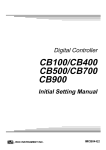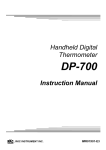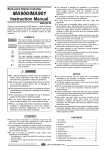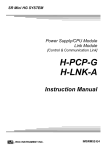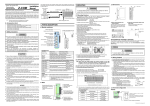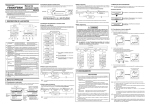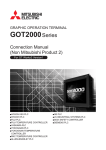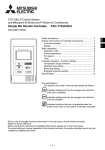Download RKC INSTRUMENT CB900 Instruction manual
Transcript
Digital Controller CB100/CB400 CB500/CB700 CB900 [Z-1021] MODBUS Communication Instruction Manual ® RKC INSTRUMENT INC. IMCB14-E1 z Modbus is a registered trademark of Schneider Electric. z Company names and product names used in this manual are the trademarks or registered trademarks of the respective companies. All Rights Reserved, Copyright ¤ 1999, RKC INSTRUMENT INC. Thank you for purchasing the RKC instrument. In order to achieve maximum performance and ensure proper operation of your new instrument, carefully read all the instructions in this manual. Please place this manual in a convenient location for easy reference. SYMBOLS WARNING : This mark indicates precautions that must be taken if there is danger of electric shock, fire, etc., which could result in loss of life or injury. CAUTION : This mark indicates that if these precautions and operating procedures are not taken, damage to the instrument may result. ! : This mark indicates that all precautions should be taken for safe usage. : This mark indicates important information on installation, handling and operating procedures. : This mark indicates supplemental information on installation, handling and operating procedures. : This mark indicates where additional information may be located. ! WARNING An external protection device must be installed if failure of this instrument z could result in damage to the instrument, equipment or injury to personnel. All wiring must be completed before power is turned on to prevent electric z shock, fire or damage to instrument and equipment. This instrument must be used in accordance with the specifications to prevent z fire or damage to instrument and equipment. This instrument is not intended for use in locations subject to flammable or z explosive gases. Do not touch high-voltage connections such as power supply terminals, etc. z to avoid electric shock. RKC is not responsible if this instrument is repaired, modified or z disassembled by other than factory-approved personnel. Malfunction can occur and warranty is void under these conditions. IMCB14-E1 i-1 CAUTION z This is a Class A instrument. In a domestic environment, this instrument may cause radio interference, in which case the user may be required to take adequate measures. z This instrument is protected from electric shock by reinforced insulation. Provide reinforced insulation between the wire for the input signal and the wires for instrument power supply, source of power and loads. z This instrument is designed for installation in an enclosed instrumentation panel. All highvoltage connections such as power supply terminals must be enclosed in the instrumentation panel to avoid electric shock by operating personnel. z All precautions described in this manual should be taken to avoid damage to the instrument or equipment. z All wiring must be in accordance with local codes and regulations. z To prevent instrument damage or failure, protect the power line and the input/output lines from high currents with a protection device such as fuse, circuit breaker, etc. z Prevent metal fragments or lead wire scraps from falling inside instrument case to avoid electric shock, fire or malfunction. z Tighten each terminal screw to the specified torque found in the manual to avoid electric shock, fire or malfunction. z For proper operation of this instrument, provide adequate ventilation for heat dispensation. z Do not connect wires to unused terminals as this will interfere with proper operation of the instrument. z Turn off the power supply before cleaning the instrument. z Do not use a volatile solvent such as paint thinner to clean the instrument. Deformation or discoloration will occur. Use a soft, dry cloth to remove stains from the instrument. z To avoid damage to instrument display, do not rub with an abrasive material or push front panel with a hard object. NOTICE z This manual assumes that the reader has a fundamental knowledge of the principles of electricity, process control, computer technology and communications. z The figures, diagrams and numeric values used in this manual are only for purpose of illustration. z RKC is not responsible for any damage or injury that is caused as a result of using this instrument, instrument failure or indirect damage. z Periodic maintenance is required for safe and proper operation of this instrument. Some components have a limited service life, or characteristics that change over time. z Every effort has been made to ensure accuracy of all information contained herein. RKC makes no warranty expressed or implied, with respect to the accuracy of the information. The information in this manual is subject to change without prior notice. z No portion of this document may be reprinted, modified, copied, transmitted, digitized, stored, processed or retrieved through any mechanical, electronic, optical or other means without prior written approval from RKC. i-2 IMCB14-E1 CONTENTS Page 1. OUTLINE ..............................................................................1 2. SPECIFICATIONS ................................................................2 3. WIRING.................................................................................3 4. COMMUNICATION SETTINGS............................................6 4.1 4.2 4.3 4.4 4.5 4.6 4.7 Communication Setting Mode .........................................................................6 Select Communication Parameters.................................................................7 Slave Address Setting .....................................................................................8 Communication Speed Setting......................................................................10 Data Configuration Setting ............................................................................12 Interval Time Setting .....................................................................................14 RS-485 Send/Receive Process Timing .........................................................17 5. MODBUS PROTOCOL.......................................................18 5.1 5.2 5.3 5.4 5.5 Message Format ...........................................................................................18 Function Code ...............................................................................................19 Communication Mode ...................................................................................19 Slave Response ............................................................................................20 Calculating CRC-16.......................................................................................21 6. MESSAGE FORMAT..........................................................23 6.1 Read Holding Registers [03H] .......................................................................23 6.2 Preset Single Registers [06H] .......................................................................24 6.3 Diagnostics (loopback test) [08H]..................................................................25 IMCB14-E1 i-3 Page 7. DATA CONFIGURATION....................................................26 7.1 Data Configuration ........................................................................................26 7.2 Data Processing Precautions ........................................................................27 7.3 Communication Data List ..............................................................................28 8. TROUBLESHOOTING .......................................................35 i-4 IMCB14-E1 1. OUTLINE This manual describes the specifications, wiring instructions and communication settings for CB100/CB400/CB500/CB700/CB900 Z-1021 with Modbus communication protocol. Slave side RS-485 MODBUS Host computer or PLC etc. or BRA-100B-2 Master side MODBUS CB100/CB400/CB500 CB700/CB900 (Slave address 1) MODBUS CB100/CB400/CB500 CB700/CB900 (Slave address 2) MODBUS CB100/CB400/CB500 CB700/CB900 (Slave address 3) MODBUS CB100/CB400/CB500 CB700/CB900 (Slave address 4) RS-232C MODBUS RS-232C/RS-485 converter BRA-100-2 Host computer or PLC etc. Junction branch box CB100/CB400/CB500 CB700/CB900 (Slave address 31) IMCB14-E1 1 2. SPECIFICATIONS (1) Interface: Based on RS-485, EIA standard (2) Connection method: 2-wire system, half-duplex multi-drop connection (3) Protocol: Modbus (4) Signal transmission mode: Remote Terminal Unit (RTU) mode (5) Synchronous method: Start/stop synchronous type (6) Communication speed: 2400 bps, 4800 bps, 9600 bps, 19200 bps (Selectable) (7) Data type: Data bit: 8 (Byte data corresponding to binary data or bit) Parity check : Without, Odd or Even (Selectable) Stop bit: 1 (8) Function codes: 03H (Read holding registers) 06H (Preset single register) 08H Diagnostics (loopback test) (9) Error check method: CRC-16 (10) Error codes: 1: Function code error (Designation of an unsupported function code) 2: When written to read only data When any address other than 0000H to 0019H is specified, etc. 3: When the data written exceeds the setting range When the specified number of data items in the query message exceeds the maximum number of data items available 4: Self-diagnostic error response (11) Maximum connection: 32 instruments including a master 2 IMCB14-E1 3. WIRING ! WARNING To prevent electric shock or instrument failure, turn off the power before connecting or disconnecting the instrument and peripheral equipment. Terminal number and signal details CB100/CB400/CB500/CB900 Terminal No. Signal name Name 13 SG 14 T/R(A) Send data/Receive data 15 T/R(B) Send data/Receive data Terminal No. Signal name 7 SG 8 T/R(A) Send data/Receive data 9 T/R(B) Send data/Receive data Slave Signal direction Master Slave Signal direction Master Signal ground CB700 IMCB14-E1 Name Signal ground 3 3. WIRING Connection to the RS-485 port of the master The master has a built-in circuit to transfer send/receive data alternatively. RS-485 Paired wire Master SG T/R(A) SG T/R(A) T/R(B) T/R(B) Slave y y y RD (RXD):Receive data Send/Receive transfer signal Shielded twisted pair wire SG SD (TXD):Send data SD (TXD) and RD (RXD): Negative logic T/R(A) T/R(B) Slave (31 max.) Use a terminal resistor with a combined resistance of 100 : on the last controller. Connection to the RS-232C port of the master A RS-232C/RS-485 communication converter is requited. Paired wire RS-485 SG SG T/R(A) T/R(A) T/R(B) T/R(B) RS-232C Slave Shielded twisted pair wire RS-232C/RS-485 converter Master Use a terminal resistor with a combined resistance of 100 : on the last controller. When the master uses Windows 95/NT, use a RS-232C/RS-485 converter with an automatic send/receive transfer function. Recommended: CD485, CD485/V manufactured by Data Link, Inc. or equivalent. 4 IMCB14-E1 3. WIRING Connection with up to 31 slaves and one master Master Master RS-232C RS-485 RS-232C/RS-485 converter RS-485 or BRA-100B-2 BRA-100B-2 BRA-100B-2 RS-485 Slave address example 1 2 Slaves 3 4 Slaves 29 30 31 Slaves For all pertinent details on the RS-232C/RS-485 converter and junction branch box (BRA100B-2), see the respective instruction manuals. IMCB14-E1 5 4. COMMUNICATION SETTINGS To establish communication parameters between master and slave, it is necessary to set the slave address, communication speed, data configuration and interval time on each slave in the communication mode. The CB900 controller will be used as an example, but the same instructions apply to all CB Series controllers with Modbus protocol. 4.1 Communication Setting Mode 1. When the power to the instrument is turned on, the input type, input range and PV/SV display mode will be automatically displayed in that order. 2. To go to the communication setting mode, you must be in either PV/SV display mode or the SV setting mode. Press and hold the SET key and press the <R/S key at the same time to initiate communication settings. The first parameter to be displayed will be the slave address, Add. PV PV SV SV AT OUT1 OUT2 ALM1 ALM2 AT OUT1 OUT2 ALM1 ALM2 SET R/S PV/SV display mode SET R/S Communication setting mode Add -Slave address setting The number segment being set will be brighter than the others in the SV display To return to the PV/SV display mode, press and hold the SET key and press the <R/S key at the same time. 6 IMCB14-E1 4. COMMUNICATION SETTINGS 4.2 Select Communication Parameters To select parameters in communication setting mode, press the SET key. The parameters are displayed and sequenced in the order of slave address, Add, communication speed, bPS, data configuration, bIT and interval time set value, InT. Display flowchart Power On Input type and input range display Display changes automatically PV/SV display mode (Display for approx. 4 sec) Press the SET key. SV setting mode Press and hold the SET key and press the <R/S key at same time. Communication setting mode PV Slave address (Add) SV Press the SET key. PV Communication speed (bPS) PV/SV display mode SV Press the SET key. PV Data configuration (bIT) Press and hold the SET key and press the <R/S key at same time. SV Press the SET key. PV Press the SET key. IMCB14-E1 Interval time set value (InT) SV 7 4. COMMUNICATION SETTINGS 4.3 Slave Address Setting The slave address must be set before Modbus communication can begin. The slave address number is set with numbers from 1 to 99. The factory set value is 0 and two-way communication is not possible when the address is 0. Symbol Name Slave address Setting range 1 to 99* Description Set the controller slave address. Factory set value 0 Add * Two-way communication is not possible when the address is 0. When the communication parameter is changed, turn the power on and off again to refresh and make the new value effective. All slave address settings must be stored by pressing the SET key. If changes are made and the SET key is not pressed within one minute, the display will automatically return to the PV/SV display mode and the slave address will return to the value prior to set change. Setting procedure Example: Setting the slave address to 15 1. Go to the communication setting mode so that slave address, Add, is displayed. PV SV AT OUT1 OUT2 ALM1 ALM2 SET R/S Slave address 8 IMCB14-E1 4. COMMUNICATION SETTINGS 2. Press the UP key to enter 5 at the first digit from the right. PV SV AT OUT1 OUT2 ALM1 ALM2 SET R/S 3. Press the <R/S key to high-light the second digit from the right. PV SV AT OUT1 OUT2 ALM1 ALM2 SET R/S 4. Press the UP key to enter 1 at the second digit form the right. PV SV AT OUT1 OUT2 ALM1 ALM2 SET R/S 5. Press the SET key to store the new slave address. The display automatically goes to the next communication parameter, bPS. IMCB14-E1 9 4. COMMUNICATION SETTINGS 4.4 Communication Speed Setting The communication speed of 2400bps, 4800bps, 9600bps or 19200bps is set with numbers from 0 to 3. To change the number of the digit, press the UP or DOWN key. Symbol Name Communication speed bPS Setting range 0 : 2400 bps 1 : 4800 bps 2 : 9600 bps 3 : 19200 bps Description Select the communication speed Factory set value 2 Set the same communication speed for both the slave and the master. When the communication parameter is changed, turn the power on and off again to refresh and make the new value effective. All communication speed settings must be stored by pressing the SET key. If changes are made and the SET key is not pressed within one minute, the display will automatically return to the PV/SV display mode and the communication speed will return to the value prior to set change. Setting procedure Example: Setting the communication speed to 1: 4800 bps 1. Go to the communication setting mode so that slave address, Add, is displayed. SET key once, so the communication speed symbol, bPS, appears. Then, press the PV SV AT OUT1 OUT2 ALM1 ALM2 SET R/S Communication speed 10 IMCB14-E1 4. SETTING FOR COMMUNICATION 2. Press the DOWN key to enter 1 (4800 bps) at the first digit from the right. PV SV AT OUT1 OUT2 ALM1 ALM2 SET R/S 3. Press the SET key to store the new communication speed. the next communication parameter, bIT. IMCB14-E1 The display automatically goes to 11 4. SETTING FOR COMMUNICATION 4.5 Data Configuration Setting The data configuration shown below is set with numbers from 1 to 3. digit, press the UP or DOWN key. Symbol Name Data configuration bIT Setting range 0, 6 or 7 See Data To change the number of the Description Select data configuration during communication Factory set value 0 Configuration Table Data configuration table Setting Data bit 0 8 1 to 5 Parity bit Stop bit None 1 Do not set 1 to 5. Malfunction may result. 6 8 Even 1 7 8 Odd 1 Set the same data configuration for both the slave and the master. When the communication parameter is changed, turn the power on and off again to refresh and make the new value effective. All data configuration settings must be stored by pressing the SET key. If changes are made and the SET key is not pressed within one minute, the display will automatically return to the PV/SV display mode and the data configuration will return to the value prior to set change. 12 IMCB14-E1 4. SETTING FOR COMMUNICATION Setting procedure Example: Setting the data configuration to 6: 8 data bits, even parity and 1 stop bit. 1. Go to the communication setting mode so that slave address, Add, is displayed. key until the data configuration symbol, bIT, appears. Press the SET PV SV AT OUT1 OUT2 ALM1 ALM2 SET R/S Data configuration 2. Press the UP key to enter 6 at the first digit from the right. PV SV AT OUT1 OUT2 ALM1 ALM2 SET R/S 3. Press the SET key to store the new data configuration. The display automatically goes to the next communication parameter, InT. IMCB14-E1 13 4. SETTING FOR COMMUNICATION 4.6 Interval Time Setting The interval time from 0 to 250 ms is set with numbers from 0 to 150. To shift the digit, press the <R/S key. To change the number of the digit, press the UP or DOWN key. Symbol Name Interval time set value Setting range 0 to 150* Description Set the value to set the interval time Factory set value 5 InT * 0 to 250 ms can be set by using 0 to 150. Formula to calculate interval time and interval time set value Interval time = Interval time set value u 1.666 ms Interval time set value = Interval time y 1.666 ms When the communication parameter is changed, turn the power on and off again to refresh and make the new value effective. All interval times must be stored by pressing the SET key. If changes are made and the SET key is not pressed within one minute, the display will automatically return to the PV/SV display mode and the interval time will return to the value prior to set change. Setting procedure Example: Setting the interval time to 250 ms. 1. Go to the communication setting mode so that slave address, Add, is displayed. key until the communication speed, InT, appears. Press the SET PV SV AT OUT1 OUT2 ALM1 ALM2 SET R/S Interval time set value 14 IMCB14-E1 4. SETTING FOR COMMUNICATION 2. Calculate the interval time set value by using the formula on the previous page. The interval time set value must be a whole number. If you get a number with a decimal fraction, round to the nearest whole number. Interval time set value: 250 ms y 1.666 ms 150 (Round to the nearest whole number) The actual interval time re-calculated by using the interval time set value, 150: 150 u 1.666 ms 249.9 (Approx. 250 ms) Enter an interval time set value of 150, calculated as show above, on the controller. 3. Press the DOWN key to enter 0 at the first digit from the right. PV SV AT OUT1 OUT2 ALM1 ALM2 SET R/S 4. Press the <R/S key to high-light the second digit from the right. PV SV AT OUT1 OUT2 ALM1 ALM2 SET IMCB14-E1 R/S 15 4. SETTING FOR COMMUNICATION 5. Press the UP key to enter 5 at the second digit from the right. PV SV AT OUT1 OUT2 ALM1 ALM2 SET R/S 6. Press the <R/S key to high-light the third digit from the right. PV SV AT OUT1 OUT2 ALM1 ALM2 SET R/S 7. Press the UP key to enter 1 at the third digit from the right. PV SV AT OUT1 OUT2 ALM1 ALM2 SET R/S 8. Press the SET key to store the new interval time. communication parameter, Add. 16 The display automatically goes back to the IMCB14-E1 4. SETTING FOR COMMUNICATION 4.7 RS-485 Send/Receive Process Timing The sending and receiving of RS-485 communication is conducted through two wires; consequently, the transmission and reception of data requires precise timing. The following processing times are required during data send/receive. Slave process timing Procedure details Read holding registers [03H] IMCB14-E1 Time (ms) Response transmission time after the slave receives the query message Preset single register [06H] 13 ms max. Response transmission time after the slave receives the query message Diagnostics (loopback test) [08H] 6 ms max. Response transmission time after the slave receives the query message 6 ms max. 17 5. MODBUS PROTOCOL The master controls communication between master and slave. A typical message consists of a request (query message) sent from the master followed by an answer (response message) from the slave. When master begins data transmission, a set of data is sent to the slave in a fixed sequence. When it is received, the slave decodes it, takes the necessary action, and returns data to the master. 5.1 Message Format The message consists of four parts: slave address, function code, data, and error check code which are always transmitted in the same sequence. Slave address Function code Data Error check CRC-16 Message format ■ Slave address The slave address is a number from 1 to 99 manually set at the front key panel of the controller. Although all connected slaves receive the query message sent from the master, only the slave with the slave address coinciding with the query message will accept the message. ■ Function code The function codes are the instructions set at the master and sent to the slave describing the action to be executed. The function codes are included when the slave responds to the master. For details, see 5.2 Function Code. ■ Data The data to execute the function specified by the function code is sent to the slave and corresponding data returned to the master from the slave. For details, see 6. MESSAGE FORMAT, 7. DATA CONFIGURATION and 7.3 Communication Data List. ■ Error check An error checking code (CRC-16: Cyclic Redundancy Check) is used to detect an error in the signal transmission. For the calculation method of CRC-16, see 5.5 Calculating CRC-16. 18 IMCB14-E1 5. MODBUS PROTOCOL 5.2 Function Code zFunction code contents Function code (Hexadecimal) Function 03H Read holding registers 06H Preset single register 08H Diagnostics (loopback test) Contents Measured value (PV), alarm status, current transformer input, etc. Set value (SV), alarm set value, PID constants, PV bias, etc. (For each word) Diagnostics (loopback test) zMessage length of each function (Unit: byte) Function code (Hexadecimal) Function Query message Response message Min 8 Max 8 Min 7 Max 255 03H Read holding registers 06H Preset single register 8 8 8 8 08H Diagnostics (loopback test) 8 8 8 8 5.3 Communication Mode Signal transmission between the master and slaves is conducted in Remote Terminal Unit (RTU) mode. RTU mode Items Data bit length Start mark of message End mark of message Message length Data time interval Error check Contents 8 bit (Binary) Unused Unused See 5.2 Function Code 24 bit's time or less* CRC-16 * The data time intervals in one query message from the master must be 24 bit's time or less. If the data time interval exceeds 24 bit's time, the slave regards the transmission as ended and because the message format is incomplete, the slave does not respond. IMCB14-E1 19 5. MODBUS PROTOCOL 5.4 Slave Responses (1) Normal response zIn the response message of the Read Holding Registers, the slave returns the read out data and the number of data items with the same slave address and function code as the query message. zIn the response message of the Preset Single Register, the slave returns the same message as the query message. zIn the response message of the Diagnostics (loopback test), the slave returns the same message as the query message. (2) Defective message response zIf the query message from the master is defective, except for transmission error, the slave returns the error response message without any action. Slave address Function code Error code Error check CRC-16 Error response message zIf the self-diagnostic function of the slave detects an error, the slave will return an error response message to all query messages. zThe function code of each error response message is obtained by adding 80H to the function code of the query message. Error code 1 2 3 4 Contents Function code error (Designation of an unsupported function code) When written to read only data When any address other than 0000H to 0019H is specified When PID constants or anti-reset windup (ARW) data are set to 0 and 1 is entered at self-tuning (ST) function When either one of PID constants and anti-reset windup (ARW) data are written during execution of the self-tuning (ST) function When the data written exceeds the setting range When the specified number of data items in the query message exceeds the maximum number of data items available Self-diagnostic error response (3) No response The slave ignores the query message and does not respond when: z The slave address in the query message does not coincide with any slave address settings. z The transmission parameter of the master does not coincide with that of the slave. z Transmission error such as overrun, framing, parity and etc., is found in the query message. z Data time interval in the query message from the master exceeds 24 bit's time. 20 IMCB14-E1 5. MODBUS PROTOCOL 5.5 Calculating CRC-16 The Cyclic Redundancy Check (CRC) is a 2 byte (16-bit) error check code. After constructing the data message, not including start, stop, or parity bit, the master calculates a CRC code and appends this to the end of the message. The slave will calculate a CRC code from the received message, and compare it with the CRC code from the master. If they do not coincide, a communication error has occurred and the slave does not respond. The CRC code is formed in the following sequence: 1. Load a 16-bit CRC register with FFFFH. 2. Exclusive OR () the first byte (8 bits) of the message with the CRC register. Return the result to the CRC register 3. Shift the CRC register 1 bit to the right. 4. If the carry flag is 1, exclusive OR the CRC register with A001 hex and return the result to the CRC register. If the carry flag is 0, repeat step 3. 5. Repeat step 3 and 4 until there have been 8 shifts. 6. Exclusive OR the next byte (8 bits) of the message with the CRC register.. 7. Repeat step 3 through 6 for all bytes of the message (except the CRC). 8. The CRC register contains the 2 byte CRC error code. When they are appended to the message, the low-order byte is appended first, followed by the high-order byte. IMCB14-E1 21 5. MODBUS PROTOCOL The flow chart of CRC-16 START FFFFH o CRC Register CRC Register next byte of the message o CRC Register 0on Shift CRC Register right 1 bit Carry flag is 1 No Yes CRC Register A001H o CRC Register n+1on No n!7 Yes No Is message complete ? Yes END The symbol indicates an exclusive OR operation. The symbol for the number of data bits is n. 22 IMCB14-E1 6. MESSAGE FORMAT 6.1 Read Holding Registers [03H] The query message specifies the starting register address and quantity of registers to be read. The contents of the holding registers are entered in the response message as data, divided into two parts: the high-order 8 bits and the low-order 8 bits, arranged in the order of the register numbers. Example: The contents of the three holding registers from 0000H to 0002H are the read out from slave address 2. Query message Slave address Function code Starting number Quantity CRC-16 High Low High Low High Low 02H 03H 00H 00H 00H 03H 05H F8H First holding register address The setting must be between 1 and 125 (0001H and 007DH) Normal response message Slave address Function code Number of data First holding register contents Next holding register contents Next holding register contents CRC-16 High Low High Low High Low High Low 02H 03H 06H 00H 64H 00H 00H 00H 00H 44H 4DH Number of holding registers u 2 Error response message Slave address 80H Function code Error code CRC-16 IMCB14-E1 High Low 02H 83H 03H F1H 31H 23 6. MESSAGE FORMAT 6.2 Preset Single Register [06H] The query message specifies data to be written into the designated holding register. The write data is arranged in the query message with high-order 8 bits first and low-order 8 bits next. Only R/W holding registers can be specified. Example: Data is written into the holding register 0006H of slave address 1. Query message Slave address Function code Holding register number Write data CRC-16 High Low High Low High Low 01H 06H 00H 06H 00H C8H 68H 5DH Any data within the range Normal response message Slave address Function code Holding register number Write data CRC-16 High Low High Low High Low 01H 06H 00H C6H 00H 08H 68H 5DH Contents will be the same as query message data. Error response message Slave address 80H Function code Error code CRC-16 24 High Low 01H 86H 02H C3H A1H IMCB14-E1 6. MESSAGE FORMAT 6.3 Diagnostics (Loopback Test) [08H] The master's query message will be returned as the response message from the slave. checks the communication system between the master and slave. Example: This function Loopback test for slave address 1 Query message Slave address Function code Test code Data CRC-16 High Low High Low High Low 01H 08H 00H 00H 1FH 34H E9H ECH Test code must be set to 00 Any pertinent data Normal response message Slave address Function code Test code Data CRC-16 High Low High Low High Low 01H 08H 00H 00H 1FH 34H E9H ECH Contents will be the same as query message data. Error response message Slave address 80H Function code Error code CRC-16 IMCB14-E1 High Low 01H 88H 03H 06H 01H 25 7. DATA CONFIGURATION 7.1 Data Configuration The numeric range of data used in Modbus protocol is 0000H to FFFFH. the setting range is effective. Only the set value within FFFFH represents -1. Data processing with decimal points ■ Data with decimal points The Modbus protocol does not recognize data with decimal points during communication. z Data with one decimal place Current transformer input 1 Current transformer input 2 (Z-168 specification) Control loop break alarm Example: 00C8H Heater break alarm 1 Heater break alarm 2 (Z-168 specification) When heater break alarm (HBA) 1 set value is 20.0 A; 20.0 is processed as 200, 200 = Heater break alarm 1 High Low 00H C8H ■ Data without decimal points Alarm 1 status Alarm 2 status Burnout LBA deadband Autotuning (AT) Self-tuning (ST) Integral time Example: When integral time is 50 seconds, 50 is processed as 50, 50 = 0032H Integral time 26 Derivative time Anti-reset windup Heat-side proportioning cycle time Cool-side proportional band Cool-side proportioning cycle time Set data lock function RUN/STOP function High Low 00H 32H IMCB14-E1 7. DATA CONFIGURATION ■ Data whose decimal point's presence and/or position depends on input range The position of the decimal point changes depending on the input range type because the Modbus protocol does not recognize data with decimal points during communication. The following data can have one of three decimal point positions: z No decimal point z One decimal place z Two decimal places The input range for voltage/current input is fixed at 0.0 to 100.0%. For details, see Input Range Table 2 on P.34. Measured value (PV) Set value (SV) Alarm 1 set value Alarm 2 set value Example: Heat-side proportional band Deadband PV bias When the temperature set value is -20.0 qC; -20.0 is processed as -200, -200 = 0000H - 00C8H = FF38H Set value (SV) High Low FFH 38H 7.2 Data Processing Precautions zFor 03H (data read from the holding register), an error response message is returned when any address other than 0000H to 0019H is specified as the starting number. zFor 06H (data write to the single holding register), an error response message is returned when data is written to any address other than 0000H to 0019H. zRead data of unused channel and undefined address is 0. zAny attempt to write to an unused channel is not processed as an error. into an unused channel. Data can not be written zIf data range or address error occurs during data writing, the data written before error is in effect. IMCB14-E1 27 7. DATA CONFIGURATION 7.3 Communication Data List The communication data list summarizes data addresses (holding register numbers), names, attributes, setting ranges and factory set values. (Attribute Attribute Address Name 00H 01H 02H 03H 04H 05H 06H 07H Measured value (PV) Current transformer input 1 Current transformer input 2 *1 Alarm 1 status Alarm 2 status Burnout Set value (SV) Alarm 1 set value 08H Alarm 2 set value 09H 0AH 0BH Heater break alarm 1 Heater break alarm 2 *2 Control loop break alarm R/W R/W R/W 0CH LBA deadband R/W 0DH Autotuning (AT) R/W 0EH Self-tuning (ST) 28 *3 RO: Read only R/W: Read and Write) Factory Data range or item description set value RO RO RO Within input range 0.0 to 100.0 A 0.0 to 100.0 A RO RO RO R/W R/W 0: OFF 1: ON 0: OFF 1: ON 0: OFF 1: ON Within input range 0 Temperature input: Temperature Process alarm, deviation alarm, SV input: alarm: 50 or 50.0 -1999 to +9999 qC [qF] or -199.9 to +999.9 qC [qF] Voltage/current inputs: Voltage/ Deviation alarm: -span to +span current (Within 9999) inputs: Process alarm, SV alarm: 5.0 Within input range 0.0 to 100.0 A 0.0 0.0 to 100.0 A 0.0 0.1 to 200.0 min. 8.0 (0.0 can not be set.) Temperature input: 0 0 to 9999 qC [qF] Voltage/current inputs: 0 to 100 % of span 0: Autotuning (AT) end or 0 suspension 1: Autotuning (AT) start* *After AT is completed, setting will automatically change to 0 0: Self-tuning (ST) suspension 0 1: Self-tuning (ST) start Continued on the next page. R/W - IMCB14-E1 7. DATA CONFIGURATION Continued from the previous page. (Attribute Attribute Address Name 0FH Heat-side proportional band (P) *4 R/W 10H Integral time (I) *4 R/W 11H Derivative time (D) *4 R/W 12H Anti-reset windup (ARW) *4 R/W 13H Heat-side proportioning cycle time R/W 14H Cool-side band Deadband R/W 15H proportional R/W 16H Cool-side proportioning cycle time R/W 17H PV bias R/W IMCB14-E1 RO: Read only R/W: Read and Write) Factory Data range or item description set value Temperature input: 1 (0.1) to span or Temperature 9999 (999.9) qC [qF] input: Voltage/current inputs: 30 (30.0) 0.1 to 100.0 % of span (ON/OFF action control when set to Voltage/ 0 or 0.0.) current Can not be set while the self-tuning inputs: (ST) function is On 3.0 1 to 3600 sec (0: PD control) 240 Can not be set while the self-tuning (ST) function is On 1 to 3600 sec (0: PI control) 60 Can not be set while the self-tuning (ST) function is On 1 to 100 % of heat-side proportional 100 band (0: Integral action OFF) Can not be set while the self-tuning (ST) function is On 1 to 100 sec (0 can not be set.) *5 Can not be set if the control output is current output. 1 to 1000% of heat-side proportional 100 band (0 can not be set.) Temperature input: 0 or 0.0 -10 to +10 qC [qF] or -10.0 to +10.0 qC [qF] Voltage/current inputs: -10.0 to +10.0 % of span 1 to 100 sec (0 can not be set.) *6 Can not be set if the control output is current output. -span to +span 0 or 0.0 However, temperature inputs: -1999 to +1999 qC [qF] or -199.9 to 999.9 qC [qF] Continued on the next page. 29 7. DATA CONFIGURATION Continued from the previous page. (Attribute Address Attribute Name RO: Read only R/W: Read and Write) Factory Data range or item description set value 18H Set data lock function R/W 0 to 7 19H RUN/STOP function R/W 0: RUN 1: STOP *1 For the current transformer input 2 function, Z-168 specification is required. *7 0 0 *2 For a unit without Z-168 specification, the read data is 0. *3 When heating proportional band (P), integral time (I), derivative time (D) or anti-reset windup (ARW) is set to 0, self-tuning (ST) cannot be set to 1, self-tuning start. Error code 2 is sent. *4 The heat-side proportional band (P), integral time (I), derivative time (D) and anti-reset windup (ARW) cannot be set while the self-tuning (ST) function is being executed. Error code 2 is sent. *5 Relay contact output: 20 sec Voltage pulse output, trigger output for triac driving, triac output: 2 sec *6 Relay contact output: 20 sec Voltage pulse output, triac output: 2 sec *7 Details of set data lock selection. Set data Set value (SV) 0 1 2 3 4 5 6 7 (-) Unsettable-Data locked u u u u - Alarm setting set value (Alarm 1, Alarm 2) u u u u (u) Settable-Data unlocked Other setting items u u u u - The data lock function only prevents setting changes being made from the front keys. changes can still be made through communication transmission. Setting Reading RO (read only) and R/W (read/write) unused data are not processed as an error at read holding registers, but read data will be 0. Any attempt to write unused data is not processed as an error. the slave. 30 Data can not be written into IMCB14-E1 7. DATA CONFIGURATION Input Range Tables Input Range Table 1 Input type Input range K Thermocouple (TC) J R S IMCB14-E1 0 to 200 qC 0 to 400 qC 0 to 600 qC 0 to 800 qC 0 to 1000 qC 0 to 1200 qC 0 to 1372 qC 0 to 100 qC 0 to 300 qC 0 to 450 qC 0 to 500 qC 0 to 800 qF 0 to 1600 qF 0 to 2502 qF 20 to 70 qF 0 to 200 qC 0 to 400 qC 0 to 600 qC 0 to 800 qC 0 to 1000 qC 0 to 1200 qC 0 to 450 qC 0 to 800 qF 0 to 1600 qF 0 to 2192 qF 0 to 400 qF 0 to 300 qF 0 to 1600 qC 0 to 1769 qC 0 to 1350 qC 0 to 3200 qF 0 to 3216 qF 0 to 1600 qC 0 to 1769 qC 0 to 3200 qF 0 to 3216 qF Code Input Range K 01 K 02 K 03 K 04 K 05 K 06 K 07 K 13 K 14 K 17 K 20 K A1 K A2 K A3 K A9 J 01 J 02 J 03 J 04 J 05 J 06 J 10 J A1 J A2 J A3 J A6 J A7 *1 R 01 *1 R 02 *1 R 04 *1 R A1 *1 R A2 *1 S 01 *1 S 02 *1 S A1 *1 S A2 Continued on the next page. 31 7. DATA CONFIGURATION Continued from the previous page. Input type Input range E N T Thermocouple (TC) PL II U L 32 0 to 800 qC 0 to 1000 qC 0 to 1600 qF 0 to 1832 qF 0 to 1200 qC 0 to 1300 qC 0 to 2300 qF 0 to 2372 qF -199.9 to +400.0 qC -199.9 to +100.0 qC -100.0 to +200.0 qC 0.0 to 350.0 qC -199.9 to +752.0 qF -100.0 to +200.0 qF -100.0 to +400.0 qF 0.0 to 450.0 qF 0.0 to 752.0 qF 0 to 1300 qC 0 to 1390 qC 0 to 1200 qC 0 to 2400 qF 0 to 2534 qF -199.9 to +600.0 qC -199.9 to +100.0 qC 0.0 to 400.0 qC -199.9 to +999.9 qF -100.0 to +200.0 qF 0.0 to 999.9 qF 0 to 400 qC 0 to 800 qC 0 to 800 qF 0 to 1600 qF Code Input Range *2 *2 *2 *2 *2 *2 E E E E N N N N T T T T T T T T T A A A A A U 01 02 A1 A2 01 02 A1 A2 01 02 03 04 A1 A2 A3 A4 A5 01 02 03 A1 A2 01 *2 U 02 U 03 *2 U A1 *2 U A2 U A3 L 01 L 02 L A1 L A2 Continued on the next page. IMCB14-E1 7. DATA CONFIGURTION Continued from the previous page. Input type *1 *2 Input range -199.9 to +649.0 qC -199.9 to +200.0 qC -100.0 to +50.0 qC -100.0 to +100.0 qC -100.0 to +200.0 qC 0.0 to 50.0 qC 0.0 to 100.0 qC 0.0 to 200.0 qC 0.0 to 300.0 qC Pt100 : 0.0 to 500.0 qC -199.9 to +999.9 qF -199.9 to +400.0 qF -199.9 to +200.0 qF RTD -100.0 to +100.0 qF -100.0 to +300.0 qF 0.0 to 100.0 qF 0.0 to 200.0 qF 0.0 to 400.0 qF 0.0 to 500.0 qF -199.9 to +649.0 qC -199.9 to +200.0 qC -100.0 to +50.0 qC -100.0 to +100.0 qC JPt100 : -100.0 to +200.0 qC 0.0 to 50.0 qC 0.0 to 100.0 qC 0.0 to 200.0 qC 0.0 to 300.0 qC 0.0 to 500.0 qC Accuracy is not guaranteed between 0 to 399 qC (0 to 799 qF). Accuracy is not guaranteed between -199.9 to -100.0 qC (-199.9 to -158.0 qF). IMCB14-E1 Code Input Range D D D D D D D D D D D D D D D D D D D P P P P P P P P P P 01 02 03 04 05 06 07 08 09 10 A1 A2 A3 A4 A5 A6 A7 A8 A9 01 02 03 04 05 06 07 08 09 10 33 7. DATA CONFIGURATION Input Range Table 2 Input type Input range DC 0 to 5 V DC 0 to 10 V* DC 1 to 5 V Current input DC 0 to 20 mA (mA) DC 4 to 20 mA * For this voltage range, Z-1010 specification is required. Code Input Range Voltage input (V) 34 0. 0 to 100.0 % 4 5 6 7 8 01 01 01 01 01 IMCB14-E1 8. TROUBLESHOOTING ! WARNING To prevent electric shock or instrument failure, always turn off the system z power before replacing the instrument. To prevent electric shock or instrument failure, always turn off the power z before mounting or removing the instrument. To prevent electric shock or instrument failure, do not turn on the power until z all the wiring is completed. To prevent electric shock or instrument failure, do not touch the inside of the z instrument. All wiring must be performed by authorized personnel with electrical z experience in this type of work. This section lists some basic causes and solutions for Modbus communication problems. If you can not find a solution, contact your nearest RKC sales office or agent for additional information about replacement or repair. Symptom No response Probable cause The controller power is not turned on Solution Turn on the power There communication cable is improperly Confirm the connection method connected Breakage in the communication cable Replace the cable Detachment of the communication cable Confirm the connection condition Problems with the connectors or contacts Check and replace the wiring in the connector The communication speed or bit structure Confirm each setting settings are different The address specification is different Confirm the address numbers A transmission error (overrun error, framing Re-transmit after time-out occurs or error, parity error or CRC-16 error) is found in verify communication program the query message The time interval between adjacent data in the query message is too long, exceeding 24 bit's time Instrument failure Replace instrument or return for repair Continued on the next page. IMCB14-E1 35 8. TROUBLESHOOTING Continued from the previous page. Symptom Probable cause Solution Error code 1 Function code error (An unsupported function code was specified) Confirm the function code Error code 2 Written to read only data. Confirm the register address of holding Any address other than 0000H to 0019H is specified. PID constants or anti-reset windup Set the PID constants and anti-reset (ARW) data are set to 0 and 1 is entered windup (ARW) data to any number at self-tuning (ST) function other than 0. Either one of PID constants and anti-reset Set the self-tuning (ST) function to 0. windup (ARW) data are written during execution of the self-tuning (ST) function. Error code 3 The data written exceeds the setting Confirm the setting data range. When the specified number of data items Re-set the data within the range of 1 in the query message exceeds the to 125 (0000H to 007DH). maximum number of data items available. Error code 4 Self-diagnostic error Turn off the power to the instrument. If the same error occurs when the power is turned back on, contact your nearest RKC sales office or agent. Error codes 1 to 4 indicate that an error response message has been transmitted. 36 IMCB14-E1 The 1st edition: Sep. 1999 RKC INSTRUMENT INC. HEADQUARTERS: 16-6, KUGAHARA 5-CHOME, OHTA-KU TOKYO 146-8515 JAPAN PHONE: 03-3751-9799 (+81 3 3751 9799) E-mail: [email protected] FAX: 03-3751-8585 (+81 3 3751 8585) IMCB14-E1 SEP.1999












































